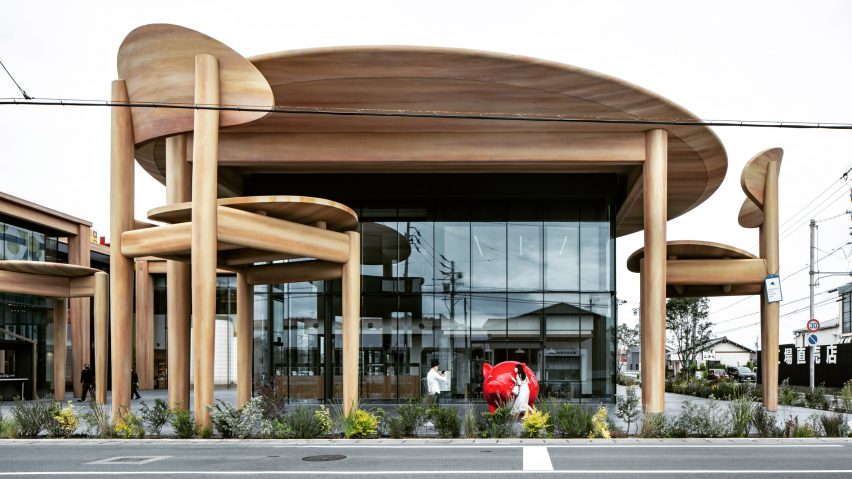A set of giant wooden tables and chairs shelter the glass buildings of Sweets Bank, the headquarters of sweet company Shunkado in Hamamatsu City, Japan, designed by Nikken Sekkei.
Described by the practice as a "social media-friendly" building, the oversized furniture, which is thirteen times the regular scale, is modelled on furniture from Shunkado's cafe.
"The site's outsized, but carefully designed tables and chairs are intended as an expression of the Shunkado corporate slogan: 'we want people to spend family time at the table with sweets'," explained Nikken Sekkei.
"In the modern age of social media, in which a single photo can instantly capture hearts and minds, the image of the building itself becomes the medium, attracts people to regional cities, and creates memorable experiences for posting to the world."
A mixed-use facility, the building combines offices for Shunkado with a restaurant and cafe, as well as a branch of local bank Hamamatsu Iwata Shinkin, the combination of which gave the project its name: Sweets Bank.
"The building is composed of two major elements: furniture as shelter from the rain and sun, and glass boxes that ensure comfort," explained the practice.
"The outsized table and chairs were designed to closely represent actual furniture, while overcoming challenges related to structure, finish, drainage and mechanical systems, creating a reality that enhances the city and attracts people," it continued.
The project is split into a pair of two-storey glass blocks. A smaller block to the south contains offices for the bank, while the larger block to the north houses a cafe and shop on the ground floor and offices for Shunkado above.
At the entrance to both blocks, the oversized tables and chairs create sheltered terraces, dotted with sculptures including an oversized gift bag, sake bottle, stool and a red pig.
The terrace appears to peel upwards at the site's southwestern corner, creating a vertical surface on which the name of the project is displayed in metal lettering.
Inside the cafe, giant cups and teapots have been used to create tables and sculptures, continuing the playful character of the exterior.
The offices themselves are more minimal and understated, with simple interiors framing views of the surrounding furniture through the large windows.
"The glass boxes were designed abstractly and simply detailed to serve as a furniture backdrop," said the practice.
On the roof, the tables are finished with imitation table settings, with mechanical services concealed by patterned covers designed to look like gift boxes.
Previous projects by Nikken Sekkei include the Ariake Gymnastics Centre in Tokyo, designed for the delayed 2020 Olympic and Paralympic games to be a celebration of timber construction. The studio also created the Olympic Village Plaza from 40,000 pieces of wood.
The photography is by Kenta Hasegawa unless stated otherwise.

